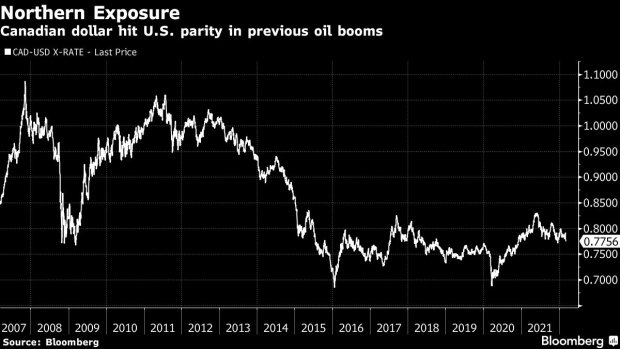Mar 8, 2022
Oil Surge Favors Canada’s Producers as Currency Helps Too
, Bloomberg News

(Bloomberg) -- Soaring oil prices are disproportionately favoring Canada’s energy companies over their U.S. counterparts because of a market quirk: unlike past oil booms, this one hasn’t been accompanied by a surge in the Canadian dollar.
Even as the Ukraine war has propelled oil prices to their highest level since 2008, the Canadian dollar has failed to appreciate against the U.S. dollar, which has benefited from flight-to-safety buying. That contrasts with the 2008 and 2011 oil rallies when the loonie briefly exceeded the U.S. dollar in value.
While Canadian energy companies sell their oil in U.S. dollars, most of their costs are in Canadian currency. Even after factoring in a discount to West Texas Intermediate, they still collected about C$140 a barrel for heavy oil on Monday -- a record.
“Every single company is generating more cash flow out of the oil sands than they ever have in their history,” Mark Little, chief executive officer of Suncor Energy Inc., said at the at the CERAWeek by S&P Global conference in Houston.
Oil sands giant Suncor’s shares rose to their highest since January 2020, before the pandemic. Rival Canadian Natural Resources Ltd.’s stock price has more than doubled in the past year, rising to a record C$79.55 on Tuesday. Cenovus Energy Inc.’s shares are trading at their highest level since late 2016 and MEG Energy Corp.’s since 2015.
Canadian oil producers are benefiting in other ways as well. The heavy grade of crude produced in the oil sands is a suitable substitute for Russian fuel oil that’s now banned from importation into the U.S. and U.K. Meanwhile, a new pipeline to the U.S. has alleviated bottlenecks experienced in the past by Canadian producers and shrunk the discount that they typically earn for their crude.
DeltaStream Energy Corp., a small, closely-held heavy oil producer in central Alberta, will see cash flow for the year surge to C$350 million, about double what it was in 2021, Roger Tang, chief executive officer, said by phone. The company plans to increase drilling in the second half of the year with the goal of boosting production from a forecast record of 17,000 barrels a day by June to an even greater 20,000 barrels a day by year end.
“At this price, the payout is very quick,” he said. “Investors get their money back.”
©2022 Bloomberg L.P.





